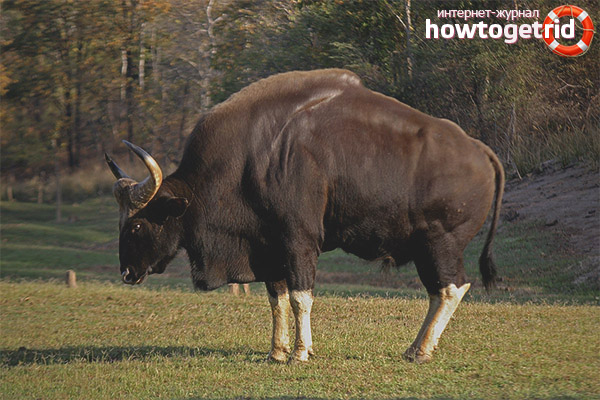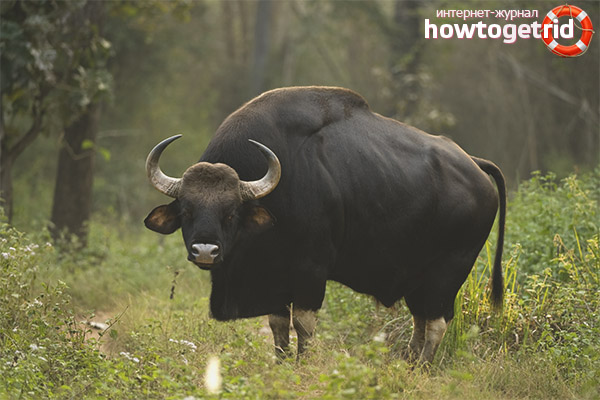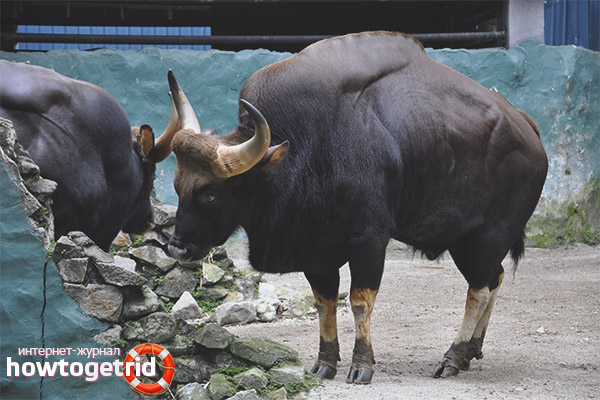The content of the article
The bull haur is rightfully considered the largest representative among cattle. A cloven-hoofed animal comes from India, and today is considered rare, and is also a giant among other species of bulls.
Description and Key Features
By its size, the animal can be compared with a bison, but there are noticeable differences between them: the bison wins in the weight category, and the gaur has impressive dimensions. The body length of the gaura reaches 3 meters, and the weight can exceed the figure of 1.5 tons. Horns grow in the shape of a crescent. Most often elongated up and 90 cm long. A striking feature is the presence of a bulge between the horns of the gaura on the forehead.
The body of the bull is covered with stiff coat, which perfectly protects the skin from external influences. The color of the coat may be black or reddish. Older individuals have a darker color, fresh colors are inherent in young ones.
Gaur is considered a domesticated animal. On the farm, it is usually called mitan or guyel. They are used as labor or put on meat. Home animals are especially smaller than representatives of the wild, and are more calm in nature.
Enemies
The disappearance of this species is associated with excessive hunting of poachers. Among the natural enemies of the bulls, crocodiles and tigers can be noted.
Lifestyle
Inhabits haur in Central and Southeast Asia. A large number of representatives of the species live in India. They are also found in Thailand, Vietnam, Cambodia and other countries.
If we talk about the Indian bull, then its habitat is considered forests. Gaura usually prefer
- deciduous forests;
- evergreens.
Sometimes the choice falls on a forest with a pond. It is very rare to meet a bull in an open area, as representatives of the species try to avoid such territories for their own safety.
In the afternoon, bulls graze in the green. Usually they do this in herds, the number of goals in which does not exceed 10-12 individuals. The herd includes 2 males and 6 females, and also young growth is taken into account. The reason for changing the feeding regime from day to night may be the location of human bulls near the habitat. Animals do not seek to leave their shelter until they are completely sure that there is no threat around.
Surprisingly, the head of the herd is the female. During the period of movement, she goes ahead, but if the herd recedes, then her place is behind. To stop or warn the herd, the leader emits special signals in the form of piercing snorts. As soon as the herd stops, the formation of battle order begins.
The Gaurs prefer not to attack first. They are distinguished by their peaceful nature and, whenever possible, avoid emerging conflicts. They do this in the form of a retreat, hiding from danger in the forest. If the situation is critical and you can’t leave without a fight, the Gauras attack mercilessly. The victim either suffers severe injuries or is thrown dead dead for several meters. As a result of such a defense, one rock is noticeably obliterated in bulls.
Another interesting fact: old bulls prefer to leave the herd and live as hermits.
Gaura Food
This type of bull is considered herbivore. The diet of gaurs consists of various herbs, leaves, bamboo seedlings and shrubs. Animals prefer to feed either early in the morning or at dusk.
Bulls drink quite a lot.You can often meet bathing bulls. They love water and in any free minute they do not mind refreshing themselves in any reservoir.
In the heat, the bulls prefer to hide from the sun in the shade of large trees, and also try to eat the most saturated food moisture.
Reproduction and longevity
Typically, the breeding season falls at the beginning of November and lasts until the end of April. At this time, single males can join the herds in order to eventually irrigate one of the females. To attract the partner’s attention, the opponents make various invocative sounds reminiscent of the deer. You can hear them at a distance of 2 kilometers, as they are very loud.
Also, males can compete for the female’s attention through a duel. Thus, they demonstrate their strength, which is why they adore the ladies. During the fight, the bull turns sideways to the enemy and starts to snort loudly, trying to intimidate him. The head of the male is inclined quite low, and one horn is directed towards the second bull. In fact, it rarely comes to a real fight. Usually, a duel ends at the moment of demonstrating one's own power. If, nevertheless, it comes to battle, then the rivals try to inflict as little damage to each other as possible.
A pregnant female carries the fetus for nine months. Throughout this time, she tries to avoid open spaces, and when the moment of childbirth comes, she goes into the thickets of shrubs. Most often, females give birth to one calf, a little less often - twins. She returns to the herd with her offspring.
For 7-12 months, the baby is fed milk. At this time, the female is overly worried about the calf and shows aggression if it seems to her that he is in danger. She does not leave the baby for a minute.
The calves become sexually mature at the age of 2-3 years, and at this age young bulls can already form their herd. On average, the age of the animal can reach up to 30 years.
Gaurov can also be found in zoos and reserves. Society seeks to maintain an endangered species, therefore, does everything to protect the remaining individuals, as well as increase the population of gaurs.












Submit